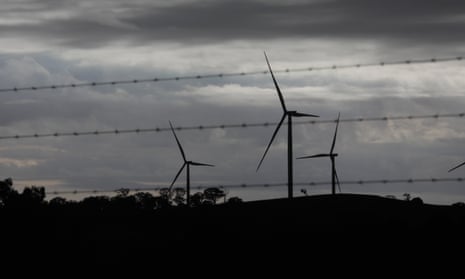Up to 11,000 renewable energy workers are expected to lose their jobs over the next two years under current government policies, according to a university analysis.
If correct, the loss of jobs would be equivalent to the abolition of the domestic-focused coal industry, which employs a little more than 10,000 people in mining thermal coal for local use and running Australia’s coal-fired power plants.
Described as the first large-scale survey of renewable energy jobs in Australia, the research from the University of Technology Sydney found the industry would be a major source of jobs in the medium term, but its short-term future would depend on how Covid-19 stimulus packages were deployed.
About 26,000 people are employed in renewable energy, but the study found this would fall to about 15,000 by 2022 under existing policies, including the Morrison government not replacing the national renewable energy target. The target, which requires energy companies to source about 23% of electricity from clean sources, was reached last year, triggering a 50% drop in large-scale renewable energy investment compared with 2018.
Conversely, renewable energy jobs would be expected to reach about 45,000 by 2025 under a “step change” scenario, set out by the Australian Energy Market Operator, consistent with the goals of the 2015 Paris agreement. The study says on this path employment in renewables would be likely to fall to about 30,000 as construction eased later this decade before rising again after 2030.
Chris Briggs, a research principal at the UTS Institute for Sustainable Futures, said up to two-thirds of renewable energy jobs would be expected to be created in regional areas. “It’s a difference of 30,000 jobs in the next few years depending on government policy,” he said.
Many of the jobs would be expected to be in identified renewable energy zones. The zones overlap with existing coal regions but are more widespread.
Briggs said it suggested renewable energy could play a meaningful role alongside other industries in creating replacement jobs in coal regions as the world reduced reliance on fossil fuels, but only if the transition was well planned and funded. Coalmining employs about 40,000 Australians, mostly for exporting companies.
“If we wait until south-east Asia stops using our coal things are going to be pretty dire,” Briggs said.
The study estimates the number of renewable energy jobs in solar, wind, hydro and batteries. It does not include related jobs in building transmission infrastructure, or new fields they may develop such as renewable hydrogen.
Business groups, the energy industry, unions and major investors are among those to have called for post-Covid stimulus spending to be designed to also address the climate crisis. The Morrison government has backed a “gas-fired recovery” from the pandemic, and has not prioritised climate-friendly policies as part of its response.
On Wednesday, the New South Wales government released a statement on coal exploration and mining that said the industry would generate regional jobs and royalties to pay for public services and infrastructure for decades to come.
John Barilaro, the deputy premier and resources minister, said while it would be important to diversify regional economies “over the next few decades” its response to coronavirus would include fast-tracking coalmining investment. He said it was not at odds with the government’s development of renewable energy zones in the state’s central west.
“The good news story today is there is a strong future for coal, a strong future for mining here in New South Wales, and more importantly (it is) part of the engine room that will get us out of the crisis,” he told reporters in the Hunter Valley.
The NSW government coal statement appears to assume the world will not meet the climate goals agreed in Paris five years ago. It suggests demand for thermal coal, which is burned in power stations, will fall by only about 10% over the next 30 years. It expects coal use for electricity to roughly double in both south-east Asia and the Indian Ocean region by 2050.
Tim Buckley, from the Institute of Energy Economics and Financial Analysis, said this assumed a world of catastrophic climate change, and was at odds with the global push by banks and institutional investors worth of trillions of dollars for the world to move away from thermal coal, leading to commitments to exit coal by several major producers.
Buckley gave the example of the Indian government, which had repeatedly said it wanted to end the country’s reliance on thermal coal imports by 2023-24 as it expanded local coalmining and renewable energy.
The International Energy Agency, which has been criticised for underestimating the rise of renewable energy, has modelled two scenarios of future thermal coal use – one roughly similar to that adopted by the NSW government, the other vastly different.
Under its “stated policies scenario”, coal demand stays flat until 2040. Under its “sustainable development scenario”, the amount of coal burned would be cut by more than half over the next 20 years.
The Intergovernmental Panel on Climate Change found limiting global heating to 1.5C above pre-industrial levels was likely to require coal power being cut by between 59% and 78% below 2010 levels by 2030, and for greenhouse gas emissions to reach net zero by 2050.
The UTS research, which formed the basis of a briefing paper by the Clean Energy Council earlier this month, will be presented at University of Melbourne seminar on Thursday.
